The state of Montana is known for its beauty, abundance of natural mineral resources, and abundance of dinosaur fossil sites. According to reports, there have been over 900 dinosaur fossil discoveries in the state. Many of Montana’s fossil discoveries have been notable, including North America’s first-ever dinosaur discovery and the continent’s first baby dinosaur bones.
The number of dinosaur fossil discoveries in the state has prompted the establishment of more than 10 dinosaur museums. In this article, you will discover five dinosaurs that lived in Montana and where their fossils can be seen today.
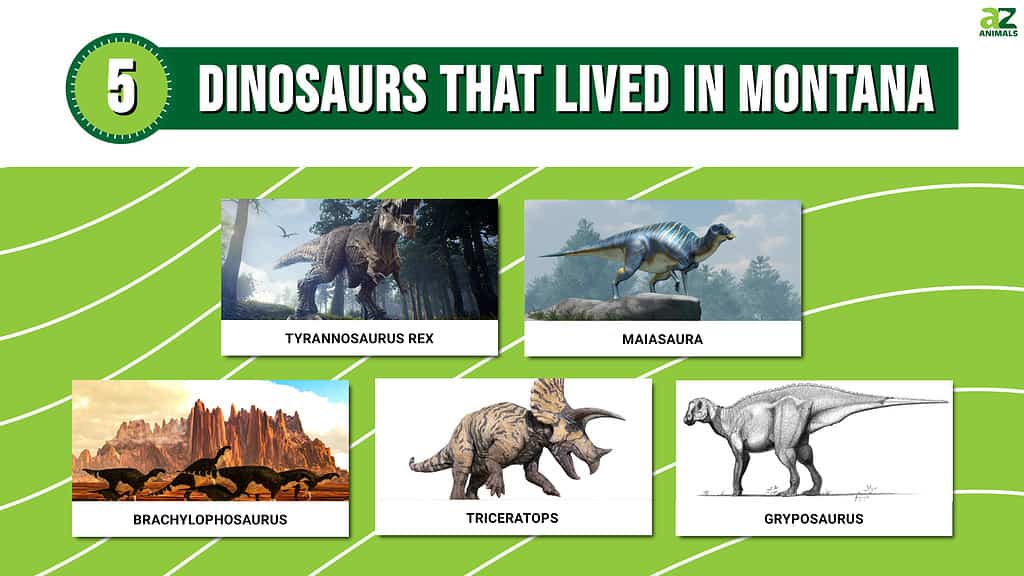
1. Tyrannosaurus Rex

The first T-Rex fossil in North America was found in Montana in 1902.
©Herschel Hoffmeyer/Shutterstock.com
The first discovery of a Tyrannosaurus Rex fossil in North America was in the state of Montana. The fossil was found in 1902 by paleontologist Barnum Brown in the Hell Creek area near Jordan. Over the years, these dinosaurs have become popular worldwide, known as large apex predators with powerful teeth and incredible speeds.
Tyrannosaurus Rex was one of the largest land carnivores ever. These giant dinosaurs stood at about 13 feet and had a body length of up to 40 feet. Adult T-Rexes could weigh more than 17,000 pounds. T-Rexes walked on two legs with three toes and have small forearms. According to reports, these large carnivores had a bite force of over 12,000 pounds and teeth as long as 12 inches, which made them terrors to other dinosaurs, even their own kind.
Montana has one of the most complete T-Rex specimens ever found worldwide. The dinosaur, tagged “Montana’s T-Rex”, was found around Fort Peck Lake in 1997. The cast of the skeleton can be seen at Fort Peck Interpretive Center in Fort Peck, while the real specimen is at the Museum of the Rockies in Bozeman.
2. Maiasaura
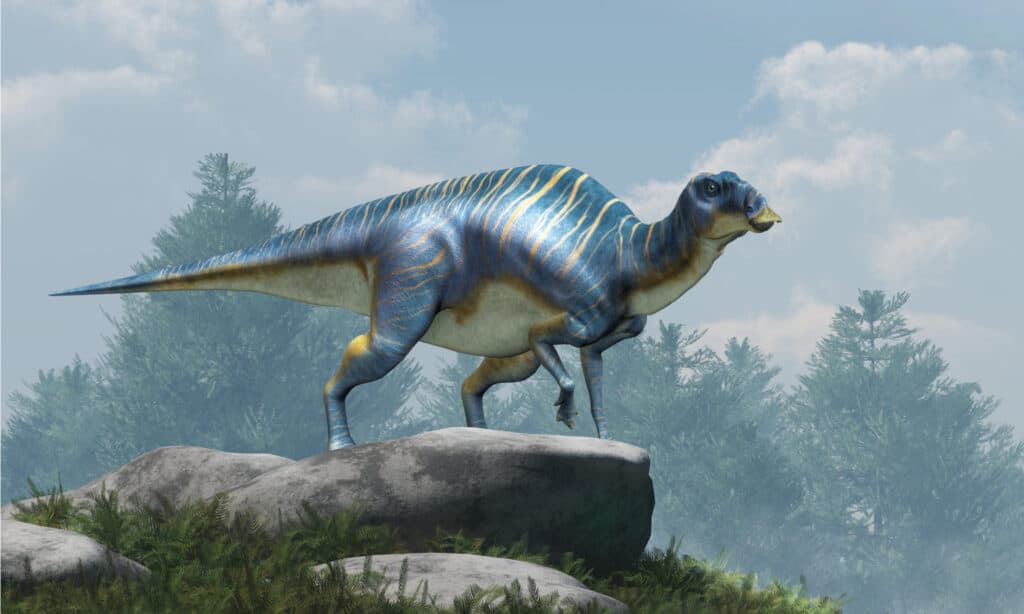
Maiasaura translated to “good mother lizard” because it is believed to have cared for its young, a notion thought impossible with dinosaurs.
©Daniel Eskridge/Shutterstock.com
The discovery of the Maiasaura dinosaur species in Montana helped create the belief that these cold-blooded reptiles mother their young. The adult fossil was found in Egg Mountain with a nest, infant dinosaurs, and eggshells. Thus, this large dinosaur is called the “good mother lizard.”
According to Montana State University, Maiasaura reached maturity at age eight and could weigh up to 2.3 tons. These giant dinosaurs could reach up to 31 feet in body length and had stiff tails, which they used for balance when moving. They had longer hind legs than fore legs, causing them to look slouched. Scientists believe that Maiasaura could raise themselves on their hind legs to nip at vegetation, such as pines and ferns, with their duck-like mouths and hundreds of short grinding teeth.
Maiasaura was believed to be abundant in Montana around 76.7 million years ago. Fossils of these North American dinosaurs can be found at Old Trail Museum and the Montana Dinosaur Museum in Choteau.
3. Brachylophosaurus
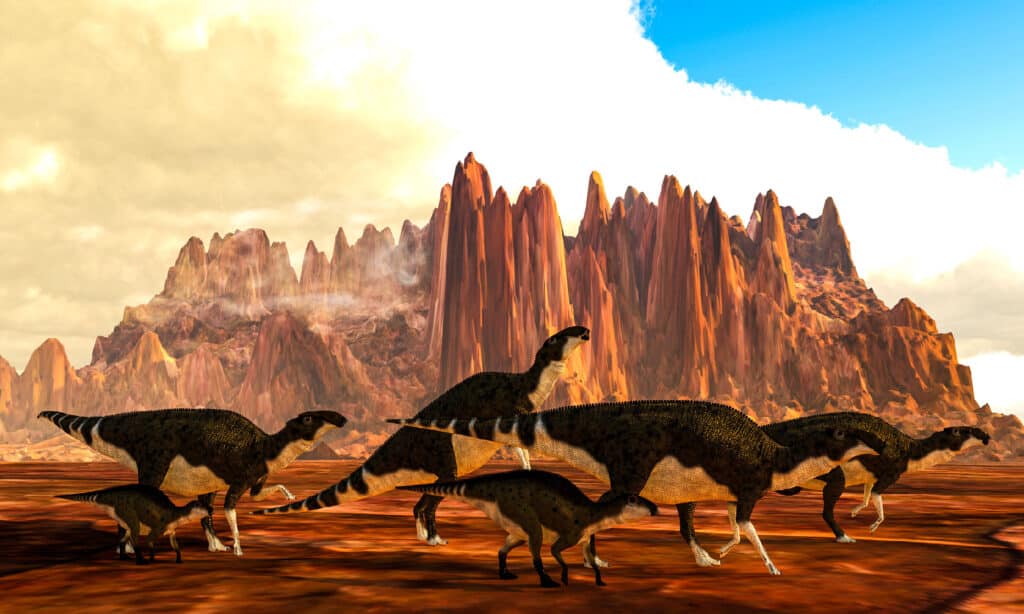
Brachylophosaurus lived about 76.7 to 81 million years ago.
©iStock.com/CoreyFord
Montana is home to one of the world’s best-preserved dinosaurs, the “mummy” Brachylophosaurus, called “Leonardo”. The fossil, found in 2001 near Malta, had most of its body covered with fossilized skin. These ancient reptiles lived in Montana about 76.7 to 81 million years ago, and several of their skeletons were found in the Judith River Formation.
Brachylophosaurus were 15,000-pound herbivores that belonged to the Hadrosauridae family, the same as Maiasaura. This dinosaur family is known for their long, flat nasal bones that resemble a duck’s bill. Montana’s 36-foot-long dinosaurs had small heads relative to their large body size, long lower arms, and a paddle-like bony crest on the top of their rear skull.
Another popular Brachylophosaurus specimen found in Montana is the near-complete specimen called “Elvis,” after the music legend. The name was given because the hip of the 33-foot-long dinosaur was found first. Specimens can be seen at the Phillips County Museum in Malta and the Museum of the Rockies in Bozeman. A cast of “Leonardo” can be found at the Great Plains Dinosaur Museum in Malta.
4. Triceratops
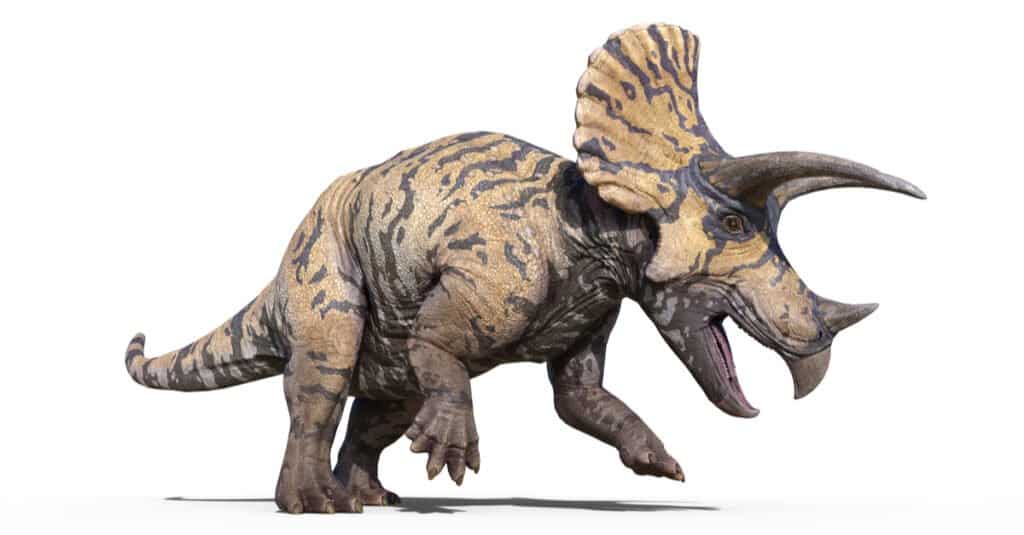
Triceratops protected themselves from predators with their trio of horns.
©freestyle images/Shutterstock.com
According to news reports, ranch owner Clayton Phipps, his friend Mark Eatman, and his cousin Chad O’Connor discovered the fossils of two dinosaurs fighting. The dinosaurs were locked together even as they had died millions of years ago. The first of the two dinosaurs recognized was Triceratops horridus, known to have had the largest horns among dinosaurs.
Triceratops stood out from other dinosaurs because of their massive skulls with bone ruff behind their skull. Its face had three horns; two four-foot horns and a smaller third. Adults grow to 10 feet in height and can have body lengths of up to 30 feet. Despite being herbivores, the 20,000-pound dinosaurs were large enough to fend off most predators and could move fast.
According to a research article, it is believed that these large dinosaurs would have lived around the Denver, Lance, and Laramie Formations. Triceratops horridus lived in North America about 68 million years ago during the Cretaceous Period. Fossils of this dinosaur can be found at the Museum of the Rockies, which has one of the world’s largest collections of Triceratops specimens.
5. Gryposaurus
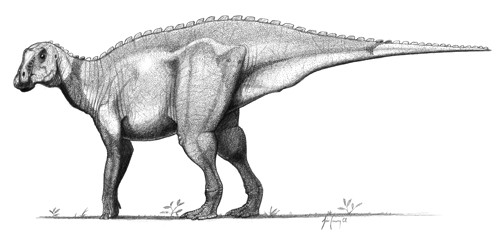
Gryposaurus existed 78 million years ago.
©John.Conway / CC BY-SA 3.0 – License
According to the Orange County Register, one of the most recent discoveries of these giant species was made on a ranch in the Badlands, MT. The find was believed to be the pelvic bones of a Gryposaurus, estimated to belong to a 30-foot-long dinosaur.
According to the Natural History Museum, Gryposaurus, which translates to the “hooked-nose lizard,” is a duck-billed dinosaur that was alive about 78 million years ago and lived in Canada and the United States. The fossil discovery of one of the three subspecies of the Hadrosaurid species revealed that these dinosaurs had different patterned scales and a prominent nasal arch that rose into a hump before their eyes.
Montana’s subspecies, Gryposaurus latidens, was estimated to be about 25 feet long and weighed about 2.5 metric tons. These herbivores’ fossils can be found in Rudyard Depot Museum in Rudyard.
Summary of 5 Dinosaurs That Lived in Montana
| Number | Dinosaur |
|---|---|
| 1 | Tyrannosaurus Rex |
| 2 | Maiasaura |
| 3 | Brachylophosaurus |
| 4 | Triceratops |
| 5 | Gryposaurus |
The photo featured at the top of this post is © Dotted Yeti/Shutterstock.com
Thank you for reading! Have some feedback for us? Contact the AZ Animals editorial team.






